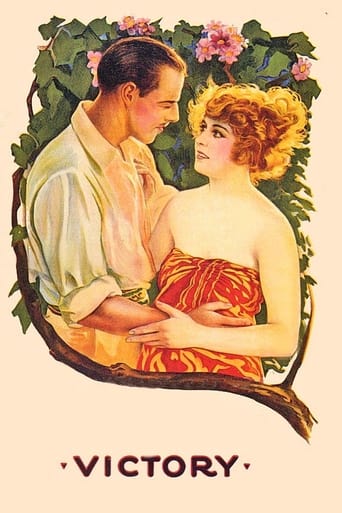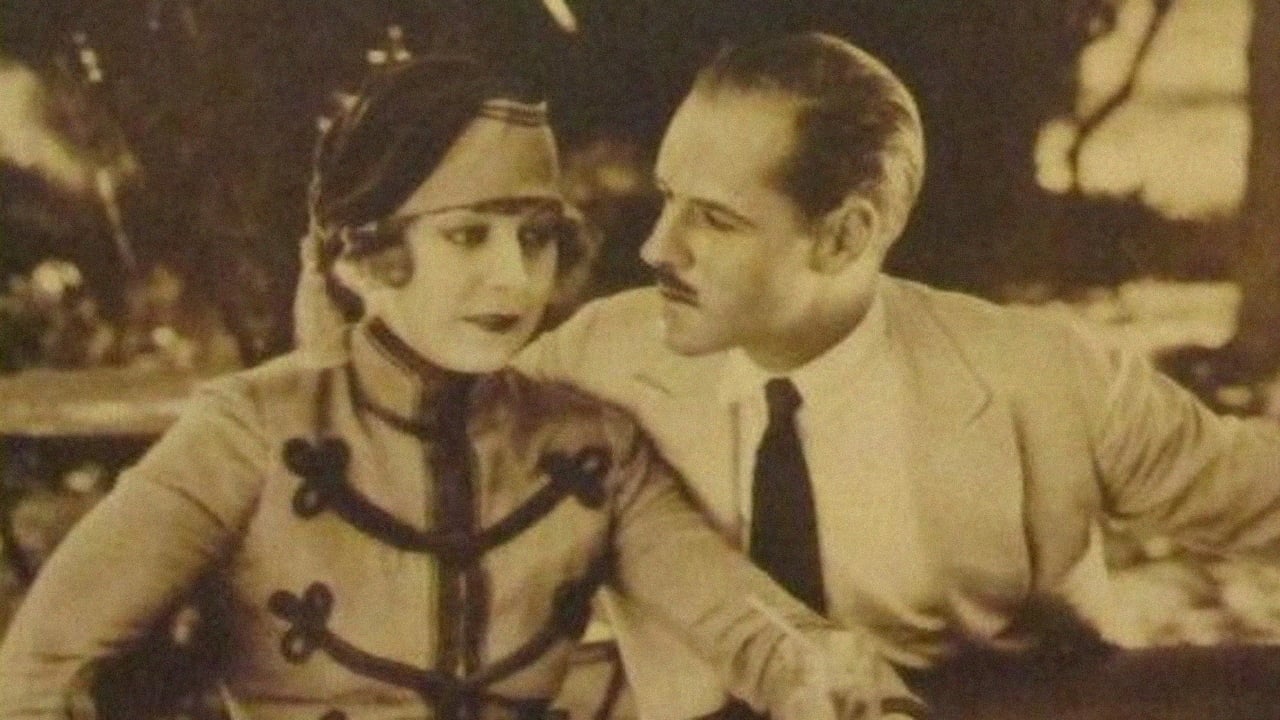Michael_Elliott
Victory (1919) ** 1/2 (out of 4) Axel Heyst (Jack Holt) lives on a deserted island where he prefers to be alone. One day he travels to town where he meets an abused woman (Seena Owen), takes pity on her and brings her back to his island. Soon her owner (Wallace Beery) sends three criminals after her. The main note here is that Lon Chaney plays one of the criminals and, as usual, he does a very nice job showing off that evil side. Holt, Owen and Beery also give fine performances, which is pretty much the only thing this film has going for it. There's some nice visuals and a nice looking erupting volcano but the story starts to drag in the middle. Directed by Maurice Tourneur.
funkyfry
Maurice Tourneur and Lon Chaney collaborated on several films in the late teens/early 20s, but this is the first I've had the privilege of seeing. I was not disappointed; I think it's a fine film and really has some very interesting visual aspects and performances.Maurice Tourneur was known as a master director in the silent era, and though not many of his films survive (I would be very curious if anyone sends me a list or responds with names of films that can be found) this film bears out his reputation. The only earlier Tourneur film I've seen is the gangster film "Alias Jimmy Valentine", and in this one Tourneur shows a similar penchant for geometric compositions and heavily contrasted shadow-play, at many points actually using silhouettes to tell the story when the action becomes intense and violent. There isn't the same kind of feeling from the way he uses these techniques however as what you get from the German masters of expressionism. Tourneur is creating an effect that emphasizes not only the formal aspects of the characters' environments but also the animal-ism of the characters themselves, whose bodies are often weirdly distorted when we do see them in silhouette. At other points Tourneur uses a kind of extreme geometric contrast to evoke the natural beauty of the world and the loneliness of nature, as in the scenes showing Alma and Heyst sailing out of town, their boat proceeding to the left at a sharp angle while a bunch of rocks rises up in the opposite direction on shore and a lone fisherman holds his rod at a sharp angle on the right. This type of shot occurs at several points in the film and seems to be a trademark Tourneur style judging from the famous still photos I've seen from "Peter Pan" and "Treasure Island" (both of which are lost if I'm not mistaken).There are some scenes in the film that I thought were incredibly graphic for the time, such as the scene where Mr. Jones pushes Pedro's brother in the fire head first, and we actually see a model of the man practically exploding in the fire. Very convincing effect, still packs some shock value because the graphic nature of the shot is so unexpected. Likewise in the later scene where Ricardo tries to kill Heyst and in the film's final moments with Pedro and Mr. Jones.Now, the performances. Might as well start with Lon Chaney's masterful turn as Ricardo. His makeup is always convincing but I've never seen him in a Mexican makeup, and it was so well done that I wouldn't have even recognized him in the early shots where the camera isn't very close if I hadn't seen the name of his character on the cast list. I've never seen Chaney so animalistic as he is in this role. While for the most part the other characters walk around very upright with creased pants and so forth, Roberto has his pants slung low around his waist and he walks with a stoop. There's a great shot of Chaney when he comes back to Heyst's house to retrieve his precious knife (he has a very fetishistic attachment to that knife), he creeps on all fours to the edge of the window and leaps through the window without raising his frame at all, landing inside the house still crouching down like a cat. In the "flashback" scenes where he's about to kill Pedro, he dances around the man's vulnerable body with his knife like a demon. Chaney projects a menace and a kind of sordid evil that is remarkable even among his many excellent film performances.His master, Mr. Jones, by contrast is a kind of quiet menace, a man who projects a kind of evil that's reptilian to Chaney's apelike brute. It's interesting that Jones and Chaney are both defined by their weapons. Jones relies on his gun, and when his gun stops working he basically is neutered. Chaney relies on his knife but as stated is much more personally attached to it. The knife is a somewhat more intimate weapon, even though Chaney throws it, and that suits the difference in style between the two villains. Bull Montana gives a remarkable performance also as Pedro as well, a man who's hidden his emotions from the world very successfully, by pretending to be evil while awaiting his chance for revenge.Wallace Beery gets all of his bits in the first half of the film. His character is just as evil as Jones and Roberto but he is the type who gets others to do his dirty work for him. He is certainly cunning as he discovers a way to get revenge on Heyst while ridding himself of the loathsome lodgers. The scenes with Beery and Chaney have a crackling kind of energy, which Tourneur highlights by concluding the scene with a shot of the 2 of them cackling conspiratorially while framed in the same shot. Beery's Shoemberg strikes me as a hypocrite, a man who hides his evil while Roberto wears his lack of morals like a badge of honor.Owen is effective as Alma, but Holt comes off a bit weak as Heyst. I guess a lot of that is just part of the role, he's quite a stick in the mud in a lot of ways.
Snow Leopard
This is a good atmospheric melodrama that successfully adapts a Joseph Conrad story of human needs and emotions, and it adds a memorable supporting performance by Lon Chaney as a bonus. The first part moves at a nice, deliberate pace, allowing the characters to define themselves and the tropic island atmosphere to sink in. Then, once it gets moving, it produces some tense moments of suspense, action, and danger.Jack Holt plays a moody recluse who is drawn into helping out a musician played by Seena Owen. Just as things start to work out for both of them, the villains - Wallace Beery, as a brutish hotel manager, and a ruthless gang that includes Chaney's character - take over the course of events. The story is rather simple in itself, but (as is often the case in Conrad's novels) the key is to watch the characters as they respond to developments.Holt is actually rather bland as the hero, and this is the main thing that keeps it from being one of the finest pictures of the late 1910s. Owen is quite sympathetic in her role, and often effectively underplays her character's emotions. Beery is well-cast and performs well, but it is Chaney who grabs the attention from everyone else whenever he is on the screen. Even in a supporting role like this, his attention to detail and his understanding of his character's nature come across clearly.The cast and story work well together and with the setting. The smoldering volcano not only provides atmosphere, but is also an appropriate image for the changes taking place inside the characters, as the tense story movies towards its conclusion.
fred3f
Minor Spoilers ahead. Maurice Troureur is one of the great directors of early cinema, and one of the least well known. He was particularly adept at creating atmosphere and composing his sets and shots (this skill is called "mise-en-scene"). Many of his films are lost and many others are simply unavailable except on bad bootleg VHS copies. "Victory," is an exception. The film, has many interesting elements, but one of the most interesting is how it foreshadows both film noir and Hitchcock. With deft touches of mise-en-scene, Tourneur, creates a steamy, sordid atmosphere in this creepy film. The three villains are perfectly cast. There is the cold emotionless intellectual criminal who kills as a means to an end (Ben Deeley), the strong brute, who has deep loyalties and deeper hatreds (Bull Montana), and finally the sadistic, killer who loves to see his victims squirm (Lon Chaney). The first shot of this charming threesome shows them looking down from the deck of a ship. The camera hangs on them, giving us time to study their personalities written so plainly on their faces. You won't see another scene like this until the 30's. Lon Chaney appears here in one of his early roles. This film was a bit of a break for Chaney. Prior to this, his roles were not as interesting, but in this film Tournour brought the best in him and from here on out he would develop his famous acting persona. The malevolent atmosphere and suspense builds in a way that is so Hitchcockian that you have to recheck the date of the film to decide who influenced whom. The lecherous, cowardly and vindictive innkeeper is perfectly played by Wallace Beery, but it is Lon Chaney who stands out as he sadistically plays mind games with anyone who has the misfortune to be around. You feel as if he might suddenly kill someone for no better reason than to improve his boredom. The other major player is Seena Owen. Largely forgotten today, probably because she made so few films. She shows herself to be a noir heroine that is easily the equal to Lon Chaney in this film. Beautiful, sensuous and knowing, the scenes between her and Chaney are priceless. In one, Chaney attempts to rape her. She successfully fights him off. As they look at each other from different parts of the room, panting from the fight, Chaney compliments her on being able to resist him. She smiles, as she adjusts her clothing, and thanks him for the compliment. A scene like that in 1919! You wouldn't see another to match it until the mid 1930's. Is it the first film noir? Did the film influence Hitchcock? Who can say? But one thing is certain, the film is well worth watching.


 AD
AD

